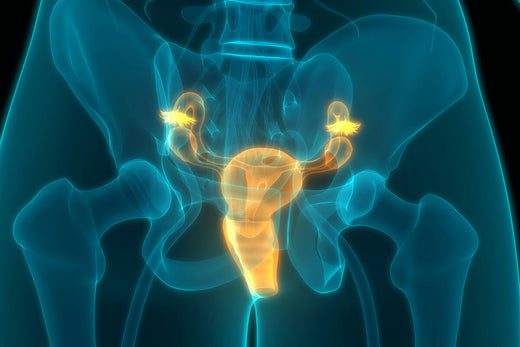Are you experiencing discomfort or pain in your pelvic area? You might be dealing with a hypertonic pelvic floor. Unlike a weak pelvic floor, an overactive pelvic floor can cause just as many problems. But don't worry - we've got you covered! In this article, we'll dive into the world of hypertonic vs hypotonic pelvic floor issues, exploring symptoms, causes, and most importantly, exercises to help you find relief. Whether you're dealing with overactive pelvic floor dysfunction or simply want to understand the difference between a tight or weak pelvic floor, we'll provide you with the knowledge and tools you need to take control of your pelvic health.
What is a hypertonic pelvic floor?
A hypertonic pelvic floor, also known as overactive pelvic floor dysfunction, occurs when the pelvic floor muscles are excessively tight and unable to relax properly. Unlike a weak pelvic floor, which can lead to incontinence, a hypertonic pelvic floor can cause difficulty emptying the bladder or bowels completely.
Symptoms of hypertonic pelvic floor
Pelvic pain or pressure
A tight pelvic floor can cause chronic pelvic pain due to the muscles being in a constant state of contraction. This may feel like constant pressure, aching or sharp pain in the pelvic region including the lower abdomen, vagina and rectum.
Difficulty with urination or bowel movements
Overactive pelvic floor muscles can make it hard to fully empty the bladder or bowels. This may cause urinary frequency, urgency, weak stream and incomplete emptying during bowel movements.
Painful intercourse
Contracted pelvic floor muscles can make penetration painful due to tightness and spasms. This is a common complaint for those with hypertonic pelvic floor dysfunction.
Frequent urge to urinate
Having to urinate more often than usual, sometimes every hour, is a classic symptom of an overactive pelvic floor. The bladder feels like it needs to empty even when it contains little urine. Along with frequent urge to urinate, pelvic pain can present similarly to UTI pains such as burning or aching in the urethra. Which is why many people mistake pelvic pain as chronic UTIs.
Causes of hypertonic pelvic floor
Chronic stress
Constant high stress levels can trigger tension in the pelvic floor muscles, leading to overactivity and spasms. Stress management techniques may help relieve this.
Past or current trauma or abuse: Trauma or abuse whether sexual, emotional, or verbal can trigger pelvic floor muscle tension. Seeking guidance from a counselor and being open with your OB/GYN and pelvic floor therapists will help open the line of communication to avoid possible triggers with pelvic exams, increasing pain.
Pelvic injuries
Injuries from childbirth, surgery or trauma can damage the pelvic floor nerves and muscles, causing them to become hypertonic. Pelvic physical therapy may be needed to treat injury-related cases.
Health conditions like
- Interstitial cystitis: A chronic bladder condition that causes pelvic pain, pressure and urgency. The bladder irritation may worsen pelvic floor muscle spasms.
- Endometriosis: The growth of uterine tissue outside the womb can irritate the pelvic nerves, leading to chronic pelvic pain and tight pelvic floor muscles.
- Prolapse: When pelvic organs shift and drop from their normal position, the pelvic floor muscles often contract excessively to support the organ.
- Chronic pelvic pain: Long-term pelvic pain itself can trigger the pelvic floor muscles to remain in a tight, contracted state.
What is the difference between hypertonic and hypotonic pelvic floor exercises?
Hypertonic pelvic floor exercises focus on relaxing overactive muscles. The goal is to release tension and improve flexibility. These exercises may include breathing techniques, gentle stretches, and relaxation methods.
In contrast, hypotonic pelvic floor exercises, often called Kegels, work to tighten and strengthen underactive muscles. These typically involve contracting and holding the pelvic floor muscles to improve support and function. Perifit's Kegel trainer device with biofeedback technology can assist with hypotonic pelvic floor exercises by providing resistance, feedback, and guidance to help strengthen the muscles effectively.
It's crucial to identify whether you're dealing with a tight or weak pelvic floor before starting any exercise regimen. Overactive pelvic floor dysfunction requires a different approach than hypotonic issues. Always consult a healthcare professional to determine the most appropriate exercises for your specific condition.
Why are exercises important for a hypertonic pelvic floor?
Exercises play a crucial role in managing a hypertonic pelvic floor, where muscles are constantly contracted. Pelvic floor relaxation exercises help retrain these muscles (1) to properly contract and relax, addressing symptoms like pelvic pain and urinary issues. Working with a physical therapist can ensure correct form and technique.
Retraining muscle function
Targeted exercises can improve muscle flexibility and coordination (2), helping to alleviate overactive pelvic floor dysfunction. Techniques like biofeedback assist in identifying the right muscle groups and monitoring progress. Kegels may not be the answer right away, but don’t worry they are in your future.
Symptom relief
Regular pelvic floor muscle release and stretching can reduce pain, enhance bladder and bowel control, and improve sexual function. With consistent practice, most people experience significant symptom relief within 3-6 weeks.
Exercises for a hypertonic pelvic floor
Relaxation techniques
For those with a hypertonic pelvic floor, relaxation is key. Gentle stretches like Child's Pose and Happy Baby (2) can help ease tension in the pelvic area. These are great examples of pelvic floor release exercises, which focus on lengthening and softening tight muscles. Deep breathing exercises and visualization can also promote muscle relaxation. The goal is to release, not strengthen, the pelvic floor.
Child’s Pose
Goal: Gently stretch the lower back and hips while encouraging pelvic floor relaxation.
- Kneel on the floor, big toes touching, knees apart (wider if comfortable).
- Sit back onto your heels and fold forward, arms stretched forward or resting by your sides.
- Let your forehead rest on the floor or a cushion.
- Inhale deeply into your belly and lower back.
- Exhale slowly, visualizing your pelvic floor softening and expanding.
- Stay in the pose for 1–3 minutes, breathing gently throughout.
Happy Baby
Goal: Open the hips and release deep pelvic tension.
- Lie on your back and bring your knees toward your chest.
- Grab the outsides of your feet (or ankles if that's more comfortable).
- Gently open your knees toward the floor, keeping your feet flexed.
- Keep your back and shoulders relaxed on the mat.
- Inhale into your lower belly.
- Exhale slowly and imagine your pelvic floor melting down into the mat.
- Hold for 1–2 minutes, staying relaxed and breathing deeply.
Specialized movements
Pelvic floor physical therapy often includes specific exercises to retrain overactive muscles. These may involve gentle contractions followed by focused relaxation. Squats and glute bridges can also help by engaging surrounding muscles, taking pressure off the pelvic floor. It's crucial to work with a qualified therapist to ensure proper technique and avoid further tightening.
Squats
Goal: Strengthen lower body muscles and support pelvic floor function.
- Stand with feet hip-width apart, toes slightly outward.
- Keep your chest lifted and back straight.
- Inhale and bend your knees, pushing your hips back (like sitting on a chair).
- Lower until thighs are parallel to the floor (or as low as comfortable).
- Keep knees aligned with your toes, not beyond them.
- Exhale and press through your heels to rise back up.
- Lightly engage glutes at the top.
- Relax the pelvic floor completely following each repetition (unless told otherwise by your therapist).
Glute Bridges
Goal: Strengthen glutes and core while supporting pelvic stability.
- Lie on your back with knees bent, feet flat and hip-width apart.
- Rest arms by your sides, palms down.
- Inhale and prepare your core.
- Exhale and press through your heels to lift your hips off the floor.
- Form a straight line from shoulders to knees.
- Gently squeeze glutes at the top—don’t overarch your back.
- Inhale and lower hips back down slowly.
- Focus on pelvic floor relaxation following each repetition.
How often should you do hypertonic pelvic floor exercises?
Finding the right balance
When dealing with a hypertonic pelvic floor, the key is to focus on relaxation rather than strengthening. Unlike exercises for a weak pelvic floor, which typically recommend 3 sets of 8-12 contractions three times daily, hypertonic pelvic floor exercises aim to release tension. The frequency of these exercises depends on individual needs and should be guided by a healthcare professional.
Tailoring your routine
A pelvic floor physiotherapist can create a personalized plan, which may include daily relaxation techniques, breathing exercises, and gentle stretches. Consistency is crucial for managing hypertonic pelvic floor dysfunction. Regular practice of these exercises, often multiple times a day, can help retrain overactive pelvic floor muscles to relax and function properly.
The goal is to alleviate tension, not to overexert. Listen to your body and adjust the frequency as needed to avoid exacerbating symptoms of an overactive pelvic floor.
How long does it take to see results from hypertonic pelvic floor exercises?
When it comes to hypertonic pelvic floor exercises, patience is key. While everyone's journey is unique, most people start noticing improvements within 4-6 weeks of consistent practice. However, for significant changes in hypertonic pelvic floor symptoms, it may take up to 3 months or longer depending on the severity of symptoms. (3)
Factors affecting progress
Several factors can influence your results:
- Severity of symptoms: Individuals with more severe hypertonic pelvic floor symptoms may see slower progress compared to those with milder symptoms. The muscles may take longer to retrain and relax.
- Consistency in performing exercises: Performing the exercises regularly as recommended by your healthcare provider is key. Missing workouts or being inconsistent can slow down your progress. Aim for daily practice if possible.
- Proper technique: Using the correct form and techniques taught by a pelvic floor physiotherapist will maximize the benefits of your workouts. Improper form may cause tension instead of relief. Having an expert monitor your progress ensures you're doing the exercises correctly.
- Combining exercises with lifestyle changes: Pairing relaxation exercises with lifestyle habits that reduce stress and muscle tension, like meditation, pelvic floor yoga and a balanced diet, may boost your results.
- Individual physiology: Factors like age, gender, medical history and genetics influence how quickly your muscles can retrain and symptoms can improve. However, with patience and consistency, most people see benefits.
Maintaining results
Once you've achieved stable symptoms, typically after 3 months, you can transition to self-management techniques. However, it's crucial to continue your exercises regularly, as symptoms may return if you stop.
Can you do hypertonic pelvic floor exercises during pregnancy?
Relaxation exercises and gentle stretching can be helpful during pregnancy for individuals with hypertonic pelvic floor and as a preparation for labor. Overly tense pelvic floor muscles may relax with deep breathing, visualization and yoga poses that open the hips.
Focus on moves that lengthen and release tension, avoiding clenching or contracting the muscles. Talk to your healthcare provider about specific stretches and relaxation techniques that may benefit you. They can guide you on the most appropriate hypertonic pelvic floor exercises for your specific situation, ensuring both your safety and the baby's well-being throughout your pregnancy journey.
Gentle daily yoga or Pilates practice of 15 to 20 minutes can also help balance tension in the pelvic floor. In fact, Pilates is good for pelvic floor strength and control, making it a great option for many. However, if symptoms worsen with any exercise, discontinue and consult your provider.
When should you see a doctor or pelvic floor therapist for hypertonicity?
If you're experiencing persistent symptoms of a hypertonic pelvic floor, it's important to seek professional help. You should consult a doctor or pelvic floor therapist if you notice:
- Frequent urination or difficulty emptying your bladder
- Straining or pain during bowel movements
- Leakage of urine or stool
- Pelvic pain or discomfort during intercourse
- Unexplained lower back pain
These could be signs of overactive pelvic floor dysfunction or hypertonic pelvic floor muscles. A healthcare professional can diagnose hypertonicity through a physical examination and may recommend pelvic floor physical therapy or other treatments to help relax and retrain your pelvic muscles.
Dealing with a hypertonic pelvic floor is a journey, not a sprint. Whether you're battling overactive pelvic floor dysfunction or simply trying to distinguish between a tight or weak pelvic floor, consistency is key. By incorporating these exercises for hypertonic pelvic floor muscles into your routine, you're taking a crucial step toward relief. Unlike exercises for a hypotonic (weak) pelvic floor that focus on strengthening, these techniques aim to relax and lengthen those overworked muscles. So, be patient with yourself, listen to your body, and don't hesitate to seek professional help if needed. With time and dedication, you can regain control and comfort in your daily life.
Sources:





